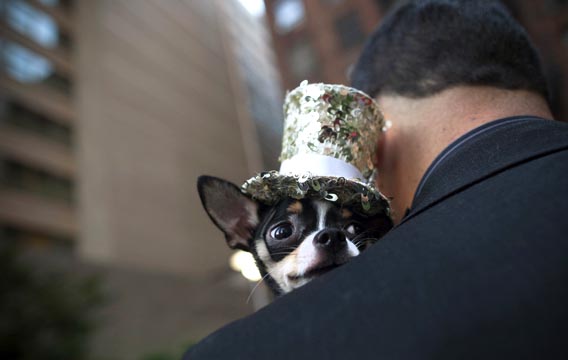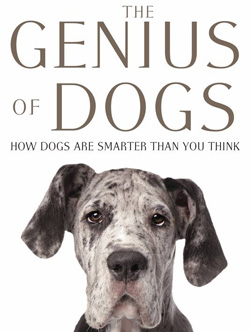Survival of the Friendliest
Did dogs “self-domesticate”? Did humans?

Photo by Andrew Kelly/Reuters
The wolves that were social enough to approach human settlements and eat our ancestors' scraps evolved into man's best friend. Evolutionary anthropologist Brian Hare tells Tiffany O'Callaghan what dogs reveal about our own evolution. Hare runs Duke University's Canine Cognition Center. He is co-author with Vanessa Woods of The Genius of Dogs. They recently launched the website dognition.com.
Tiffany O’Callaghan: You set out to study human evolution. How did you end up studying dogs?
Brian Hare: One thing that equipped humans to acquire language was our ability to read gestures. My undergraduate adviser at Emory University, Mike Tomasello, was exploring the hypothesis that this might be unique to our species. He was telling me that our closest relatives, the chimpanzees and bonobos, are not good at reading gestures the same way that we are in a cooperative context. I said, "Wait a second, I think my dog can pass the same test the apes are failing." That's how it got started.
TO: How can dogs teach us more about ourselves?
BH: The dog is the only species we've found that has some of the communicative skills that look like what infants need to acquire language and culture. So what in the world are they doing in dogs? And what evolutionary process allowed that to happen? If we can figure out how it happened in dogs, it helps us figure out how our own species evolved.
TO: Tell me about the similarities between dogs and human infants.
BH: Dogs are the only species that have been identified to date that learn words in the same way as human children—by using inferences. Show a child a red block and a green block, for example. If you then ask for "the chromium block, not the red block," most children will give you the green block, despite not knowing that "chromium" can refer to a shade of green. The child infers the name of the object. Dogs have been found to learn in the same way.
The second thing is that they make use of human gestures at a similar level of flexibility to young infants. Obviously older infants quickly outstrip what dogs can do, but the fact that there is any overlap at all is remarkable.
TO: How do you test a dog's ability to infer?
BH: One example is a simple game in which you hide food in one of two places, then show the dog the place where the food is not. They have to make an inference: If it's not there it must be the other place. They also can make social inferences. When you're pointing, for instance, they're inferring what you want, what direction it is you're suggesting they go.

Courtesy of Penguin Publishing
TO: How do dogs compare with other animals in their ability to make inferences?
BH: There are lots of flavors of intelligence. Researchers have looked at different animals and the contexts in which they are able to make inferences. Corvids, the family of birds that includes crows and ravens, make incredibly complicated inferences when it comes to using tools or outcompeting group members in hiding food, for example. What's special about dogs is that they have the ability to figure out what we want, to use humans as a tool in a way that other animals cannot.
The way that I would love for people to think about intelligence is to think of a tool box. If somebody asks you what's the smartest species or who's the smartest person, it's the equivalent of asking, what's the best tool, a hammer or a screwdriver? Well, what's the problem you're trying to solve? What is it that dogs need to solve to survive? They need to figure out how to use humans effectively.
TO: So what was it that set some wolves on the road to using humans?
BH: The folk-psychological notion of domestication is that dogs were created in our image. That 12,000 to 15,000 years ago some foraging human populations who were transitioning to agriculture raised wolves and intentionally bred them over many generations. Bearing in mind that wolves are aggressive toward people generally, eat a lot, and eat the same things that we eat, that story doesn't make much sense.
TO: So how did self-domestication take place?
BH: It's the same way that squirrels go to your bird feeder, or mice come into your house. Dogs did not evolve because humans chose to do it. It happened because a population of wolves one day spotted an easy meal—the garbage lying around where the humans were.
Those wolves would have been more friendly toward humans, tolerant and bold. The wolves exploiting that food resource then spent more time together and mated. You end up having human-friendly wolves breeding together.
TO: The endurance of the most social, bold dogs is what you call "survival of the friendliest."
BH: Exactly. Since Herbert Spencer coined the phrase "survival of the fittest," people often think of the Hobbesian notion of nature as red in tooth and claw. And, of course, many species do use aggression to stay on top. But nature is also replete with examples of species evolving to be friendlier, more tolerant and social. In those cases, the ones which are able to survive by being friendly can outcompete those which are less friendly.
Dogs as a species became more tolerant and as a result are one of the most successful mammals in the history of the planet—in terms of quality of life, numbers, distribution. I don't think there's any place where humans have gone that dogs have not also gone—even space! If you compare dogs with wolves, that population that decided to eat garbage, boy did they make the right decision.
TO: What do you mean when you suggest that humans, too, are self-domesticated?
BH: Selection of friendliness over aggression was what made dogs happen. And in our ape family, it seems that bonobos have been selected to be more friendly. That then makes us look at our own species; does that mean that we have been under selection to be less aggressive and more tolerant? That is how we went from having a dispersed distribution to being able to live in very high-density populations since the agricultural revolution.
TO: What do you make of the hypothesis that dogs played a role in domesticating us?
BH: I don't think that hypothesis is any less plausible than others I've heard that attempt to explain the transition from foraging to settled agriculture. When humans became more sedentary, dogs started appearing. Humans who were tolerant toward dogs would have had hunting partners, a home alarm system, and when things got tough, an emergency (and portable) food supply.
What's required for civilization is tolerance, so maybe these advantages pushed humans toward being more tolerant. I'm not saying it did everything, but it could have played a role. Now, it's another question how you test any of this.
TO: You suggest the increasing overlap between human and wild territory may put us on the cusp of another domestication event.
BH: Take the coyote. The coyote evolved in the western United States. There were no eastern coyotes, but now they have moved into the eastern United States. How is it that coyotes that were living in places like Yellowstone National Park now live on Manhattan Island? It must have required some type of evolution in terms of how they deal with interactions with people. Is this the same process that happened with proto-dogs? I don't know. But creatures evolve to take advantage of any niche that exists—even in high-density urban areas.
TO: Though they're impressively clever in many ways, dogs come up short in other aspects, finding it difficult to learn how to pull a rope to bring food nearer to them, for example.
BH: Yes, that is one of the areas where the only way to describe it is that they're a bit vapid. This concept of connectivity is just too much for them, which is why they end up wrapping their leads around posts. But they overcome their weaknesses by depending on humans.
TO: When you began your career in science, did you think you'd end up being "that dog guy"?
BH: (Laughs.) No. How about that for a short answer?
This article originally appeared in New Scientist.
Watch a dog take an intelligence test at New Scientist.
